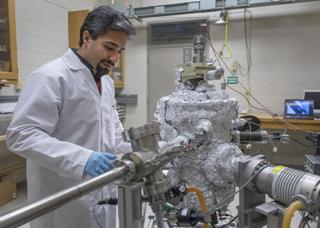Mar 4 2015
What if one day, your computer, TV or smart phone could process data with light waves instead of an electrical current, making those devices faster, cheaper and more sustainable through less heat and power consumption? That's just one possibility that could one day result from an international research collaboration that's exploring how to improve the performance of plasmonic devices.
 Masoud Kaveh-Baghbadorani, a doctoral student in UC's Department of Physics, conducts research to improve the performance of plasmonic devices. CREDIT: Jay Yocis/University of Cincinnati
Masoud Kaveh-Baghbadorani, a doctoral student in UC's Department of Physics, conducts research to improve the performance of plasmonic devices. CREDIT: Jay Yocis/University of Cincinnati
The research led by Masoud Kaveh-Baghbadorani, a doctoral student in the University of Cincinnati's Department of Physics, will be presented on March 5, at the American Physical Society Meeting in San Antonio, Texas.
The researchers are investigating the manipulation of light in plasmonic nanostructures using the dephasing and population dynamics of electron-hole-pairs in metal coated, core-shell semiconductor nanowires. The technique would minimize energy loss and heat production. The research focuses on guiding light through nanometer-thick metal films - about a thousand times thinner than a human hair - to propagate light with plasmon waves, a cumulative electron oscillation.
Plasmonics is an emerging research field, but it has limitations due to high resistivity losses in the metal films. Kaveh-Baghbadorani has been exploring the development of hybrid metal/organic semiconductor nanowires that work as an energy pump to compensate for energy losses in the metal coating.
"We have tried this with an alloy of silver, now we're trying it with gold. The purpose is to better understand and try to model how energy is getting transferred from the semiconductor nanowire into the metal. There are many different variables here to better understand this energy transfer or energy coupling," explains Kaveh-Baghbadorani. "We are working on improving the coupling between the semiconductor nanowires and the metal coating."
In addition to using a different metal, the researchers are also using a vertical alignment of nanowire structures. They also developed a method to completely surround the nanowires with layers of 10-nanometer-thick gold films. An inserted organic material works as a spacer layer to control the energy transfer from the nanowire into the metal.
"The metal results in high resistivity losses," explains co-researcher Hans Peter-Wagner, a UC professor of physics and Kaveh-Baghbadorani's advisor. "We want to overcome these losses by pumping energy from nanowire excitons, or electronic excitations, into the metal. This is the reason why we do this research."
The research is also exploring the effect of using different organic spacer layer thicknesses on the energy coupling.
"When we use different organic materials in the plasmonic structure, we can extend the lifetime of excited charge carriers, therefore they can travel longer within the structure before they get captured by the metal," says Kaveh-Baghbadorani. "By changing the organic spacer thickness, we can control the energy transfer process."
Future applications could include faster and enhanced performance of computers and other smart electronic devices, solar cells or even lead to a super-lens that results in a vast improvement of the current generation of microscopes. "We're far from being at the end of potential applications for this research and constantly thinking about new uses. The research field is extremely rich, there's no end in sight," says Wagner.
Co-researchers on the project include Wagner; Chennupati Jagadish, professor of electronic materials engineering, Australian National University; Qiang Gao, research fellow, Department of Electronic Materials Engineering, Australian National University; and Gerd Duscher, professor of materials science and engineering, University of Tennessee.